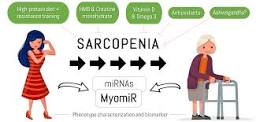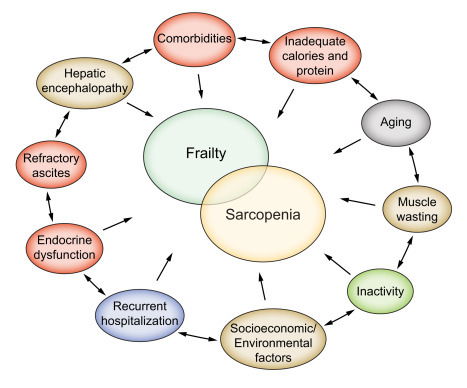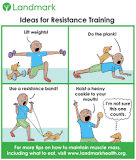SARCOPENIA

What is SARCOPENIA?
Sarcopenia. is the loss of skeletal muscle mass and strength as a result of ageing. It is a terrible condition.
"Slowly Use Your Functional Muscles"

1. To develop a habit of being able to stand ... just don’t sit! ... and don’t lie down if you can sit!
2. After the age of 50~60, it is not possible to lose weight, especially if you do not exercise and rely on eating less to lose weight! Because if all the muscles are lost, it can be very dangerous!
3. Does running, cycling or climbing hurt the knee? If you have never exercised before you can only go running, biking, or climbing in your mind as it will hurt your knees a lot! But if you have enough muscle strength and slowly develop the habit of running, cycling, and climbing, it can be a good exercise and not hurt your knees! Whether you hurt your knees or not depends on your muscle strength!
4. If an elderly person is sick and hospitalized, don't ask him to rest more ... or lie down and relax and not get out of bed! Lying down for a week loses at least 5% of muscle mass ! And the old man can't get his muscles back !
5. Don't think that you are filial by not letting the elders do any housework, and scold the maid if they do it ! Usually, many elderly people who hire helpers lose muscle faster !
6. Don't just do a single activity every day when you go to the park. Dont just shake your hands when you can also shake your legs. You must also pull the horizontal bar or move every sports equipment! Because as long as a person moves, then all the muscles of whole body will be involved! Many elderly people even have difficulty swallowing because of insufficient exercise! In the end, they could not even cough up a mouthful of sputum and die because of this!
7. Sarcopenia is more terrifying than osteoporosis ! With osteoporosis you just need to be careful not to fall, whereas sarcopenia not only affects the quality of life but also causes high blood sugar due to insufficient muscle mass! 8. The fastest loss of sarcopenia is in the muscle of the legs! Because when a person sits or lie down, the legs are not moving and the muscle strength of the legs are affected ... this is particularly important ! Don't become black feet ! So squat at least 20 to 30 times a day. Squat is not squatting down but like sitting on the toilet seat ... you can use a chair and stand up when your butt touches the seat! You MUST pay attention to sarcopenia! Go up & down stairs ... running, cycling and climbing are all great exercises and can increase muscle mass! For a better quality of life for everyone in old age ... Move... don't waste your muscle!! Aging starts from the feet upwards ! KEEP YOUR LEGS ACTIVE & STRONG !!
▪As we put on years & keep getting old on a daily basis , our feet must always remain active & strong. As we are constantly ageing / get aged, we should not be afraid of our hair turning grey (or) skin sagging ( or) wrinkles on face. ▪Among the signs of longevity, long fit life as summarized by the popular US Magazine " Prevention ", strong leg muscles are listed on the top, as the most important & essential one. Please walk daily.
▪If you don’t move your legs for just two weeks, your real leg strength will decrease by 10 years. Just walk.▪A study from the University of Copenhagen in Denmark found that both old & young, during the two weeks of inactivity, the legs muscle strength can weaken by a third which is equivalent to 20-30 years of ageing !! So just walk ▪As our leg muscles weaken, it will take a long time to recover, even if we do rehabilitation & exercises, later. WALK.
▪Therefore, regular exercise like walking, is very important.
▪The whole body weight/ load remains and rest on the legs.
▪The feet are a kind of pillars, bearing the entire weight of the human body. Walk everyday. ▪Interestingly, 50% of a person's bones & 50% of the muscles, are in the two legs. Do walk
▪The largest & strongest joints & bones of the human body are also in the legs. 10K steps/day
▪Strong bones, strong muscles and flexible joints form the Iron Triangle that carries the most important load i.e. the human body."
▪70% of human activity and burning of energy in one's life is done by the two feet.
▪Do you know this ? When a person is young, his/ her thighs have enough strength , to lift a small car of 800 kg !
▪The foot is the center of body locomotion.
▪Both the legs together have 50% of the nerves of the human body, 50% of the blood vessels and 50% of the blood is flowing through them. ▪It is the largest circulatory network that connects the body. So walk daily.
▪Only when the feet are healthy then the convention current of blood flows , smoothly, so people who have strong leg muscles will definitely have a strong heart. Walk. ▪Aging starts from the feet upwards
▪As a person gets older, the accuracy & speed of transmission of instructions between the brain and the legs decreases, unlike when a person is young. Please walk.
▪In addition, the so-called Bone Fertilizer Calcium will sooner or later be lost with the passage of time, making the elderly more prone to bone fractures. WALK. ▪Bone fractures in the elderly can easily trigger a series of complications, especially fatal diseases such as brain thrombosis.
▪ Do you know that 15% of elderly patients generally, will die max. within a year of a thigh-bone fracture !! Walk daily without fail.
▪ Exercising the legs, is never too late, even after the age of 60 years.
▪Although our feet/legs will gradually age with time, exercising our feet/ legs is a life-long task. Walk 10,000 steps
▪Only by regular strengthening the legs, one can prevent or reduce further aging. Walk 365 days
▪ Please walk for at least 30-40 minutes daily to ensure that your legs receive sufficient exercise and to ensure that your leg muscles remain healthy. You should share this important information with all your 40+years" friends & family members, as everyone is aging on a daily basis.
UNDERSTANDING SARCOPENIA more.........
Sarcopenia has been defined as an age related, involuntary loss of skeletal muscle mass and strength. Beginning as early as the 4th decade of life, evidence suggests that skeletal muscle mass and skeletal muscle strength decline in a linear fashion, with up to 50% of mass being lost by the 8th decade of life.
Treatments: Exercise & "Slowly Use Your Functional Muscles"
What is SARCOPENIA?
Sarcopenia. is the loss of skeletal muscle mass and strength as a result of ageing. It is a terrible condition.
What exactly is Sarcopenia?
Sarcopenia is a progressive and generalised skeletal muscle disorder involving the accelerated loss of muscle mass and function that is associated with increased adverse outcomes including falls, functional decline, frailty, and mortality.

What organ is affected by Sarcopenia?
In sarcopenia skeletal muscle mass - the largest body organ - is failing in its function and the term "muscle failure" was suggested. Sarcopeniat is now recognized as a serious clinical problem compromising healthy aging concept and quality of life of affected older people.
Sarcopenia has been defined as an age related, involuntary loss of skeletal muscle mass and strength. Beginning as early as the 4th decade of life, evidence suggests that skeletal muscle mass and skeletal muscle strength decline in a linear fashion, with up to 50% of mass being lost by the 8th decade of life
What are some symptoms of Sarcopenia?
Symptoms of sarcopenia can include:
- Falling.
- Muscle Weakness.
- Slow Walking Speed.
- Self-Reported Muscle Wasting.
- Difficulty Performing Normal Daily Activities
What is the best treatment for sarcopenia?
At present, resistance exercise, protein supplementation, and vitamin D have been established as the basic treatment of Sarcopenia. High-dose testosterone increases muscle power and function, but has a number of potentially limiting side effects.
Can you reverse sarcopenia?
Although some sarcopenias are a natural consequence of Aging, others are preventable. Studies show sarcopenia can be reversed, and muscle loss decreased. A healthy diet and reasonable exercise can reverse sarcopenia, which increases lifespan and improve quality of life.
At what age does sarcopenia start?Sarcopenia—defined as age-related muscle loss—can begin at around age 35 and occurs at a rate of 1-2 percent a year for the typical person. After age 60, it can accelerate to 3 percent a year. The loss may be mild, moderate, or severe—or muscles can remain in the normal range.
What organ is affected by sarcopenia?
In sarcopenia skeletal muscle mass - the largest body organ - is failing in its function and the term "muscle failure" was suggested. Sarcopeniat is now recognized as a serious clinical problem compromising healthy aging concept and quality of life of affected older people.
What triggers sarcopenia?
Sarcopenia has a multifactorial cause, with declines in activity and nutrition, disease states, inflammation, declines in neuromuscular junctions, and aging related changes in mitochondria, apoptosis, and the angiotensin system recently found to be contributory.
Can a 70 year old woman gain muscle mass?
Seniors Can Still Bulk Up On Muscle By Pressing Iron Our muscle mass decreases at surprising rates as we get older. But researchers found that people older than 50 can not only maintain but actually increase their muscle mass by lifting weights.21
How long can you live with sarcopenia?
During a median 14.4 year follow‐up period we observed 2683 deaths from all‐causes (60% of the total cohort). The median survival among subjects without sarcopenia was 16.3 years as compared with 10.3 years among subjects with sarcopenia (P < 0.001; Figure 2).
Can seniors regain lost muscle mass?
Regular exercise and strength training is the first and most effective way to regain and maintain lost muscle mass. We recommend speaking to a fitness professional and your doctor to discuss which types of exercises may be best suited for your needs.
What foods are good for sarcopenia?
Following the Mediterranean diet and higher consumption of fruits and vegetables have been associated with improved physical performance and protection against muscle wasting, sarcopenia, and frailty.
Is there any medication for sarcopenia?
Therefore, the management of sarcopenia is important for healthy aging. However, despite development efforts, to date, there remain no US Food and Drug Administration (FDA)-approved drugs for the treatment of sarcopenia (Table 1).
Is there any medication for sarcopenia?
Therefore, the management of sarcopenia is important for healthy aging. However, despite development efforts, to date, there remain no US Food and Drug Administration (FDA)-approved drugs for the treatment of sarcopenia (Table 1).
...Table 1.
| Company name | BioViva |
|---|---|
| Drug name | AAV gene therapy |
| Collaborator | NA |
| Target | Myostatin |
What foods build muscle in seniors?
10 Power Foods that Help Seniors Build Strong Muscles
- Meat: Rich in protein, animal meat is an ideal dietary option for seniors. ...
- Fatty Fish: In case one is a non-vegetarian, seniors also have the option of consuming fatty fish, which features a significant amount of protein. ...
- Tofu: ...
- Eggs: ...
- Milk: ...
- Cheese: ...
- Beans: ...
- Nuts:
Is there a test for sarcopenia?
There are many evaluation methods for the diagnosis of sarcopenia, such as dual energy X-ray absorptiometry (DXA), bioelectrical impedance assessment (BIA), computed tomography (CT), magnetic resonance imaging (MRI), and ultrasound (US), which are all employed for evaluating muscle quality.
How do I stop losing muscle mass?
Here are five ways to maintain muscle mass as you age:
- Eat protein. The body breaks down protein-rich foods into amino acids, which it uses to build muscle. ...
- Resistance train. A consistent strength training routine builds muscle mass. ...
- Increase Your Omega-3s. ...
- Check your vitamin D levels. ...
- Walk.
Does sarcopenia cause death?
Sarcopenia has been associated with many negative outcomes, such as functional disability, falls, health care costs, and even death.
What type of doctor treats sarcopenia?
In addition, geriatric specialists, in particular, are now trying to establish the age-related loss of muscles as a medical condition under the name sarcopenia, from the Greek for loss of flesh.
What helps weak legs in elderly?
To combat lower extremity weakness in your legs consider participating in daily exercise and a healthy diet. Elevate your legs: Poor circulation can put pressure onto your leg and affect the bodies lower extremities. When the legs and feet are elevated 6 – 12 inches above the heart, it relieves pressure from the legs.
Does sarcopenia affect the heart?
Modifications of lean mass are a frequent critical determinant in the pathophysiology and progression of heart failure (HF). Sarcopenia may be considered one of the most important causes of low physical performance and reduced cardiorespiratory fitness in older patients with HF.
At what age do muscles start to deteriorate?
One of the most striking effects of age is the involuntary loss of muscle mass, strength, and function, termed sarcopenia [1–3]. Muscle mass decreases approximately 3–8% per decade after the age of 30 and this rate of decline is even higher after the age of 60 (4,5)
Do you lose weight with sarcopenia?
This age-related loss of muscle mass and strength is often referred to as 'sarcopenia'. Weight loss due to an underlying disease is called 'cachexia', and it usually involves a loss of fat and muscle mass.
Why are my legs getting thinner as I get older?
Summary: Have you ever noticed that people have thinner arms and legs as they get older?
As we age it becomes harder to keep our muscles healthy. They get smaller, which decreases strength and increases the likelihood of falls and fractures.
How can I regain muscle in my legs?
Numerous experts recommend resistance and weight training as the best ways to rebuild muscle. And in addition to building muscle mass, this type of exercise increases bone mass, which is another key to remaining mobile as you age.
Do all old people get sarcopenia?
Sarcopenia, also known as muscle loss, is a common condition that affects 10% of adults who are over 50 years old. While it can decrease life expectancy and quality of life, there are actions you can take to prevent and even reverse the condition.
Can sarcopenia be painful?
Sarcopenia is associated with musculoskeletal disease, including chronic low back pain, osteoporosis, and lumbar spinal stenosis (LSS). LSS is mainly caused by degenerative changes in the lumbar spine that result in low back pain, lower extremity pain, and decreased physical function.
What is the best exercise for a 70 year old woman?
Get aerobic exercise: Most older adults need about 2½ hours of aerobic exercise, like brisk walking, every week. That's about 30 minutes on most days. Endurance exercises like walking, dancing, and playing tennis help your breathing, heart rate, and energy. Stay flexible: Try stretching and yoga.
How many steps should a 70 year old woman take daily?Normative data indicates that 1) healthy older adults average 2,000-9,000 steps/day, and 2) special populations average 1,200-8,800 steps/day.
What is the best exercise for the elderly?
The Best Exercises for Seniors
- Water aerobics. In the past years, water aerobics have become an extremely popular form of exercise among all ages, but in particular to seniors. ...
- Chair yoga. ...
- Resistance band workouts. ...
- Pilates. ...
- Walking. ...
- Body weight workouts. ...
- Dumbbell strength training.


